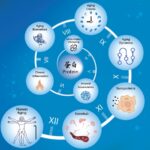The Modern Science of Longevity
In recent years, aging has transformed from an inevitable biological process into a modifiable target of medical science. Researchers across the globe are unraveling the complex mechanisms of aging—ranging from chronic inflammation and genomic instability to mitochondrial dysfunction and impaired autophagy. The goal is no longer merely to extend lifespan, but to improve healthspan—the number of years a person lives free of age-related disease.
As anti-aging research evolves from theory to clinical promise, this article reviews current advances in drug-based interventions for aging, their scientific basis, translational challenges, and future directions. From repurposed medications to cutting-edge cell therapies, we explore the most promising—and controversial—approaches on the horizon.
Repurposing Existing Drugs: From Diabetes to Longevity
One promising avenue in the anti-aging field is the repurposing of existing medications. Drugs like metformin and rapamycin have shown potential in animal models, demonstrating significant effects in delaying aging processes. Metformin, widely used for diabetes management, influences metabolic pathways and has been linked to an increase in lifespan in various species. Rapamycin, originally an immunosuppressant, has been observed to enhance autophagy, a cellular cleaning process, thereby delaying aging.
| Drug | Original Use | Anti-Aging Mechanism | Evidence |
|---|---|---|---|
| Metformin | Type 2 Diabetes | Improves insulin sensitivity, reduces inflammation, activates AMPK | Shown to increase lifespan in mice and reduce cancer risk in diabetics[1] |
| Rapamycin | Organ Transplantation | Inhibits mTOR pathway, enhances autophagy | Extends lifespan in multiple species[2] |
Although animal studies have been compelling, human trials are still underway. The TAME (Targeting Aging with Metformin) trial is currently one of the most anticipated studies evaluating metformin’s impact on age-related diseases in older adults[3].
While these drugs appear promising in animal models, the challenge remains in determining their efficacy and safety in humans. Clinical trials are complex, and the dosage and administration methods need careful optimization to ensure they are both effective and safe for human use.
Precision Anti-Aging: The Promise of Targeted Therapies
Beyond broad-acting drugs, researchers are developing precision therapeutics that target specific aging mechanisms:
- α-Klotho: A hormone associated with cognitive and renal health, α-Klotho levels decline with age. Preclinical data suggest restoring α-Klotho may improve longevity markers and neuroprotection[4].
- IL-11 and Senolytics: Targeting inflammatory cytokines and senescent cells may help reduce chronic low-grade inflammation—known as “inflammaging.”
- TERT activation: Telomerase reverse transcriptase (TERT) can preserve telomere length, a key marker of cellular aging. TERT-based therapies are being explored in gene therapy and pharmacological formats.
Despite early promise, these interventions require careful calibration. Overstimulation of telomerase, for example, could increase the risk of oncogenesis.
Supplements and Nutraceuticals: Hype vs. Hope
Dietary supplements and nutraceuticals are also being explored for their potential anti-aging benefits. Compounds like spermidine, ergothioneine, NAD+, and PQQ are popular for their theoretical benefits in supporting mitochondrial function and antioxidant activity.
| Compound | Proposed Benefit | Clinical Support |
|---|---|---|
| NAD+ precursors (NMN, NR) | Enhance mitochondrial energy, support DNA repair | Small-scale trials show metabolic improvement[5] |
| Spermidine | Induce autophagy, cardioprotection | Observational studies show longevity correlation[6] |
| PQQ | Antioxidant, mitochondrial biogenesis | Animal studies; human evidence limited[7] |
Although these supplements are widely marketed and consumed, their actual impact on longevity remains mostly unexplored in rigorous scientific terms. Consumers often turn to these products with the hope of extending their lifespan, but scientific validation through comprehensive clinical trials is necessary to substantiate their claims.
Stem Cells and Exosomes: Regeneration at the Cellular Level
Stem cell therapies and exosome treatments aim to rejuvenate aging tissues. These approaches offer a paradigm shift: from delaying aging to reversing cellular decline.
-
Mesenchymal stem cells (MSCs) are being investigated for their ability to repair damaged tissues and modulate immune responses.
-
Exosomes, the vesicles secreted by stem cells, may deliver regenerative signals without introducing whole cells—potentially reducing risk and regulatory barriers.
Yet, these therapies remain experimental, often provided in unregulated clinics. The FDA warns against unauthorized stem cell treatments due to safety risks, including tumor formation, infection, and immune rejection.
Barriers to Translation: Scientific, Ethical, and Societal Challenges
Despite impressive lab results, translating anti-aging therapies into mainstream medicine faces several challenges:
-
Species Differences: Results from mice do not always predict human outcomes.
-
Complexity of Aging: Aging is not a single disease but a multifactorial process influenced by genetics, environment, and behavior.
-
Clinical Trial Design: Defining and measuring “anti-aging” outcomes is challenging. Do we look at biomarkers, disease delay, or subjective quality of life?
-
Access and Equity: Will these therapies be affordable and equitably distributed, or widen health disparities?
Looking Ahead: The Future of Anti-Aging Medicine
Several emerging technologies could transform the anti-aging landscape:
-
Epigenetic reprogramming (e.g., Yamanaka factors) to reset cellular age
-
AI-guided drug discovery for geroprotectors
-
Personalized aging profiles using omics data and digital twins
The field is rapidly evolving. Governments and private investors alike are recognizing the importance of aging research. The global anti-aging market is projected to exceed $120 billion by 2030[8].
Beyond Lifespan to Healthspan
The pursuit of longevity is no longer science fiction. Anti-aging research now encompasses a broad spectrum of interventions—from small molecules and gene editing to cellular therapies and lifestyle modulation.
Yet, caution is warranted. While some interventions may one day become routine clinical practice, others may remain speculative or even harmful without proper regulation and oversight. As research progresses, clinicians, scientists, and the public must remain both optimistic and critical.
Ultimately, the goal is not merely to live longer—but to live better.
References
-
Bannister, C. A., et al. (2014). BMJ, 349:g4998.
-
Harrison, D. E., et al. (2009). Nature, 460(7253), 392–395.
-
Barzilai, N., et al. (2016). Cell Metabolism, 23(6), 1060–1065.
-
Kuro-o, M. (2010). Nature Reviews Nephrology, 6(10), 590–600.
-
Martens, C. R., et al. (2018). Nature Communications, 9(1), 1286.
-
Eisenberg, T., et al. (2016). Cell Reports, 16(11), 2953–2963.
-
Chowanadisai, W., et al. (2013). J. Nutritional Biochemistry, 24(12), 2076–2084.
-
Global Market Insights (2023). Anti-Aging Market Size Report.



